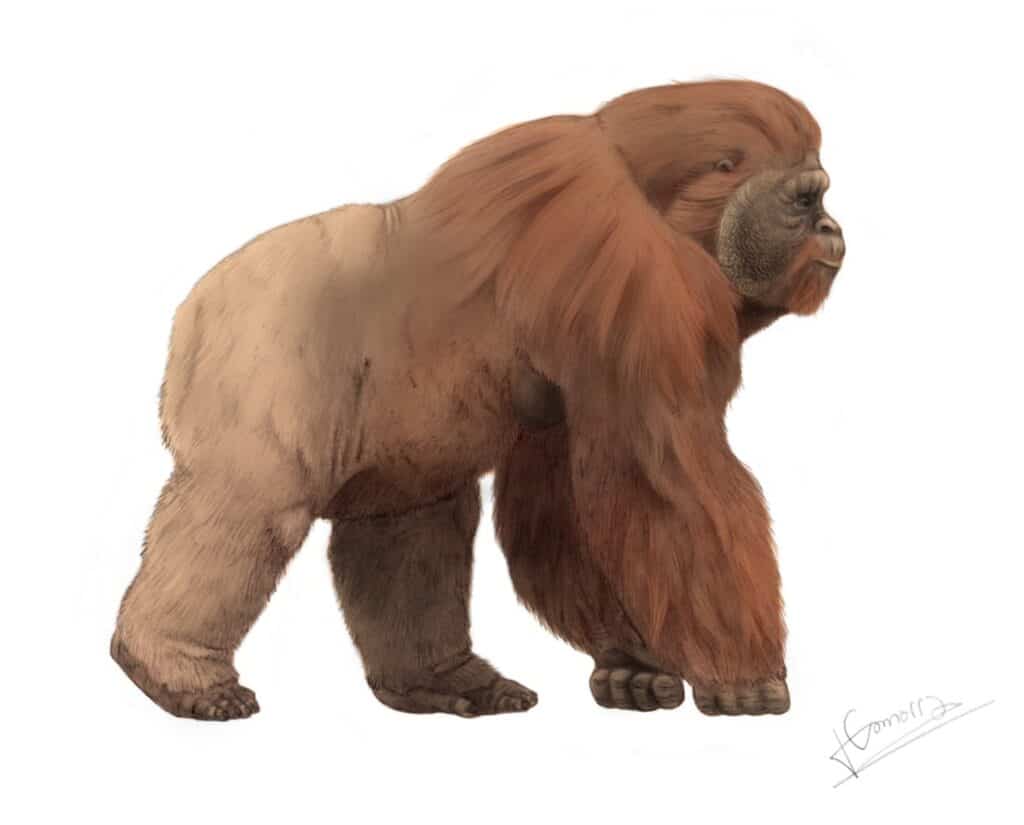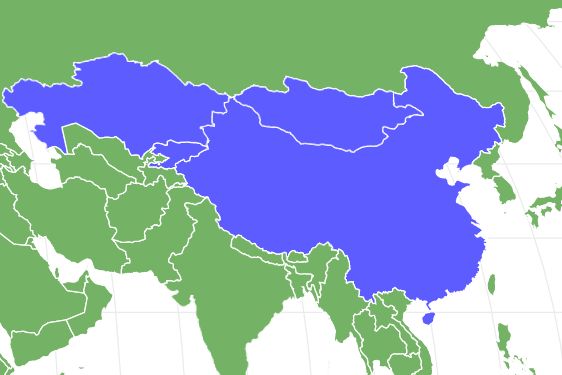Some cryptozoologists think that Gigantopithecus survives to this day as "The Bigfoot."
Advertisement
Gigantopithecus Scientific Classification
- Kingdom
- Animalia
- Phylum
- Chordata
- Class
- Mammalia
- Order
- Primates
- Family
- Hominidae
- Genus
- Gigantopithecus
- Scientific Name
- G. blacki
Read our Complete Guide to Classification of Animals.
Gigantopithecus Conservation Status
Gigantopithecus Facts
- Fun Fact
- Some cryptozoologists think that Gigantopithecus survives to this day as "The Bigfoot."
- Estimated Population Size
- Unknown
- Biggest Threat
- Climate change, big cats
- Most Distinctive Feature
- Physical size, 25% larger than modern gorillas
- Distinctive Feature
- Similarity to orangutans & gorillas
- Predators
- Big cats
- Diet
- Herbivore
- Location
- South China
View all of the Gigantopithecus images!
Gigantopithecus blacki is thought to be the largest ape ever to have existed. This massive hominid existed in southern China during the first half of the Pleistocene Epoch. With little evidence to uncover the specifics about the animal, anthropologists and paleontologists have gone to great lengths to discern the potential characteristics of this large and fascinating great ape.
Description & Size
Gigantopithecus blacki is described and recreated as a large ape resembling a larger version of a gorilla. Although the “massive gorilla” description works well for popular appeal, this animal was closer to an orangutan in appearance and ancestry.
In fact, rather than falling into the subfamily Homininae (humans, gorillas, chimps), Gigantopithecus exists in the subfamily Ponginae, which is a sister family to Homininae. The only living species of this family is the orangutan, which is divided into three subspecies (Bornean, Sumatran, and Tapanuli).
Still, Gigantopithecus is estimated to have been around 25% larger than modern-day gorillas. Paleoanthropologists suggest that the animal would have weighed in the ballpark of 600-660 pounds and stood at a whopping 9 feet tall.
Although it’s exciting to hear reports about monstrous apes, it’s important to note that researchers aren’t fixed on this size estimate. There are very few fossil remains to examine, so we won’t know the exact proportions of an average individual until there are more fossils to work with.
It’s also supposed that Gigantopithecus displayed strong sexual dimorphism. This occurs when a species’ male and female individuals display significantly different sizes and attributes. Females might have been significantly smaller than males, which makes it tough to get accurate estimates of size based on fossil records.
- Closer to orangutans than gorillas
- 25% larger than modern gorillas
- Weighed roughly 600-660 pounds
- Strong sexual dimorphism
Dental Remains
Most of the information we have on Gigantopithecus comes from teeth and jaw remains.
1,000s of teeth and numerous mandibles (lower jawbones) have been attributed to Gigantopithecus. Unfortunately, and comically, researchers believe that porcupines and their relatives likely ate most of this great ape’s fossils! Porcupines were heavily present alongside Gigantopithecus and their clade is known to feast on bones when the environment requires them to.
From the teeth that archeologists have identified, they know that Gigantopithecus had a 2.1.2.3 dental formula. That means they had two incisors, a single canine, and three sets of molars. The large size of Gigantopithecus’ molars indicates that the incisors were generally small, and some wearing on the incisors discovered could suggest that these apes had a significant underbite.
The size of its molars average around 17 mm x 21 mm. There are no other apes with molars of that size, and this is a significant detail in estimations of Gigantopithecus’ size. Further, these teeth are equipped with more enamel than any other ape known to man, which means it was able to chew thick, fibrous substances without wearing down its teeth.
- Most remains discovered have been teeth
- Most Gigantopithecus fossils likely eaten by porcupines
- Average molar size of 17 mm x 21 mm
- Teeth suggest diet of thick or fibrous substances
Possible Appearance
So, what would this great ape have looked like? It’s always difficult to guess the phenotype of an extinct animal, but experts can make some general claims about appearance based on fossil evidence.
Because of its close relationship to orangutans, it’s possible that Gigantopithecus grew orange hair. Unlike the hair of gorillas, this hair would have grown out by a few inches, or possibly a few feet as is the case with some orangutans. Further, males might have had cheek flanges and developed throat sacs that would attract females and aid in mating calls, respectively.
It would not be unlikely for Gigantopithecus to have had distinct physical attributes in place to attract partners. This is the case with nearly all animals. Still, this great ape’s relationship to orangutans (and humans, for that matter) suggests that reproduction would happen once every 5-10 years and females would raise the young for a number of years before parting ways.
Rarity in mating puts more pressure on males to present themselves and stand out, which could incentivize more elaborate, beautiful features.

©Concavenator / CC BY-SA 4.0, , via Wikimedia Commons – License
Diet – What Did Gigantopithecus Eat?
What did Gigantopithecus eat? All signs point toward the fact that this animal was an herbivore.
Carbon-13 analyses are tests to determine how and where energy flows through a food chain. Carbon-13 tests for Gigantopithecus indicate that it would have eaten mostly fruits and plants. Another indication of this is the size of the teeth, the amount of enamel coating them, and the breadth of the jaw.
Large teeth coated in excess enamel are perfect for chewing on strenuous, fibrous things. Extra enamel prevents the tooth from wearing down in the face of rough, difficult chewing. Unlike orangutans, Gigantopithecus teeth don’t show many signs of what’s known as “pitting.”
Pitting signs show up when an animal regularly eats very hard and small objects. In particular, the pit of fruits, hard nuts, seeds, and more. The ability to eat these things is usually a specialized trait developed over time, suggesting the food in question is an integral part of the animal’s life and habitat.
As that evolutionary process continues, the animal gets tied to a specific set of foods and develops a “specialist diet.” This reduces the possible food sources and environments in which the animal could live.
So, because Gigantopithecus doesn’t show signs of pitting, researchers think it might have had a generalist diet and could have lived in a variety of environments. It’s likely that this generalist diet would have included things like bamboo shoots, roots, and stems. The resilience, along with isotope analysis of the teeth, implies that these individuals ate low-lying roots and stems covered in dirt.
- Carbon analysis suggests a diet of fruits and plants
- They likely ate bamboo shoots, stems, roots, and other dirt-covered plants
- Enjoyed a generalist diet
Habitat – When and Where It lived
Most Gigantopithecus remains were discovered in South China. Specifically, numerous teeth and jaw bone discoveries have been in areas that used to be evergreen forests in subtropic regions dominated by broadleaf trees.
All examples of fossils fall into this category within Southern China, except for teeth discovered in Hainan, a providence that falls at the very southern point of China’s territory. The island of Hainan exists in a tropical rainforest, so the climate is a little different from what the majority of Gigantopithecus individuals would have been used to.
These individuals would have lived there from the Early Pleistocene through most of the Middle Pleistocene, according to the fossil record. This means they existed from roughly 2 million years ago to 300,000 years ago.
If Gigantopithecus was anything like its orangutan cousins, individuals would have been largely isolated, living among the trees and foraging on the grounds of dense forests. Most orangutan males don’t interact much with other individuals, opting only to communicate with females during mating seasons.
Females would have spent significant time raising their young, but it’s uncertain whether males would have been around the family group to be a part of the child-rearing process. So, while it’s hard to say if these animals lived in groups, we can be fairly certain that they spent most of their time in trees or on the ground in dense evergreen forests.
- Southern Chinese environment
- Occupied dense subtropical forests
- Existed from 2 million to 300,000 years ago
Threats And Predators
The uncertainty about Gigantopithecus makes it hard for researchers to identify its predators. Keep in mind that the only details we have about this animal come from its teeth and jaws.
That said, massive size certainly gave Gigantopithecus an advantage. There wouldn’t have been many predators that could use this animal as a viable prey source. Gigantopithecus would have been skilled at navigating the dense, crowded forests in which it lived, making it very hard to catch.
If we draw a parallel to orangutans, there wouldn’t have been predators hunting adult Gigantopithecus individuals on a regular basis. Orangutans deal with the rare big cat or snake, but they spend most of their time in the trees so they’re pretty well secured.
Further, Gigantopithecus lived from 2,000,000 years ago to 300,000 years ago, so there was a different array of predators on earth. There’s a lot of speculation and uncertainty as to what those predators would have looked like and how they would have behaved.
If there was a significant threat to Gigantopithecus, it would likely have been a big cat, similar to the sabertooth tiger. The Eurasian cave lion came much later than Gigantopithecus, although it occupied the same environments and likely descended from a similarly large cat that would have contended with large apes.
Gigantopithecus’ biggest threat, as we’ll find out in another section, was its shifting environment.
- It’s uncertain what Gigantopithecus‘ predators would have been
- Likely interacted with large mammals and contended with big cats
Discoveries and Fossils – Where It was Found
Fossil discoveries of Gigantopithecus are limited to fewer than twenty sites and only include teeth and mandibles.
Most confirmed teeth come from the Liucheng region of China. Another discovery of 92 teeth from the Guangxi region of South China constitutes the second-largest collection of Gigantopithecus teeth from a single area.
The discovery of this species was famously made by an anthropologist looking through teeth in a Chinese drugstore in 1935. Ralph von Koenigswald was perusing teeth sold as relics or mementos in the market, only to find that one was huge.
As an experienced paleoanthropologist, particularly in the field of Hominids, von Koenigswald identified these as molars of a large great ape. No apes with molars that large had ever been classified, so a new categorization was made.
Unfortunately, we will all have to wait until a larger set of Gigantopithecus bones is discovered to know more about this ancient ape.
Extinction – When Did It Die Out?
Evidence suggests that Gigantopithecus died out roughly 300,000 years ago in the Middle Pleistocene or “Chibanian” Era. During this time, dense forests retreated southward in the face of intensifying monsoons and the general cooling of the area. The regions that Gigantopithecus would have occupied turned into savannas that laid the way for many of the large ungulates of the Late Pleistocene.
So, the natural diet and environment in which Gigantopithecus lived wouldn’t have been able to sustain it any longer. Many individuals might have moved south along with the forests, but that change of habitat might not have provided the things necessary for survival.
The Chibanian and Late Pleistocene eras were also marked by the migration of archaic human species. These early humans, although primitive, were adept hunters and disrupted ecosystems, causing the collapse and extinction of many species. In many cases, the shifting climate and human hunting were the reasons that ancient animals went extinct.
This could have been the case with Gigantopithecus, considering that Homo erectus would have moved into Southeastern Eurasia around 800,000 years ago. H. erectus occupied mostly savannas, whereas Gigantopithecus would have remained in the forest, but there’s a real chance that they interacted.
Similar Animals to Gigantopithecus
Similar animals to Gigantopithecus include:
- Orangutans – Orangutans are the closest living relative to Gigantopithecus. They occupy the same subfamily, and are a distinct branch of the family Hominidae. Orangutans are the only great ape in this subfamily, implying that Gigantopithecus would have had more similarities with orangutans than humans or gorillas.
- Gorillas – Gorillas are similar to Gigantopithecus only in that they’re the largest living member of the family Hominidae. Gigantopithecus might have been about 25% to 30% larger than modern gorillas, but they might have shared some similarities simply as large primates occupying the same positions in various ecosystems.
- Yeti or Bigfoot – Some cryptozoologists (those who study legendary or mythical animals) believe that Gigantopithecus died in the subtropical forests in the Chibanian era. Instead, they migrated much later and took to secluded, mountainous regions, evolving into what we now know as bigfoot or the yeti. There’s no evidence to suggest this other than the fact that these animals would have looked relatively close to what we think of as “bigfoot.”
Want to Learn About More Animals Like Gigantopithecus?
View all 170 animals that start with GGigantopithecus FAQs (Frequently Asked Questions)
1. When was the Gigantopithecus alive?
Gigantopithecus was alive in the Early Pleistocene (approximately 2 million years ago) to sometime in the Middle Pleistocene (approximately 300,000 years ago).
2. How Big was Gigantopithecus?
Gigantopithecus was significantly larger than any ape known to man. It would have weighed around 660 pounds and stood at around 9 feet tall.
Thank you for reading! Have some feedback for us? Contact the AZ Animals editorial team.

















